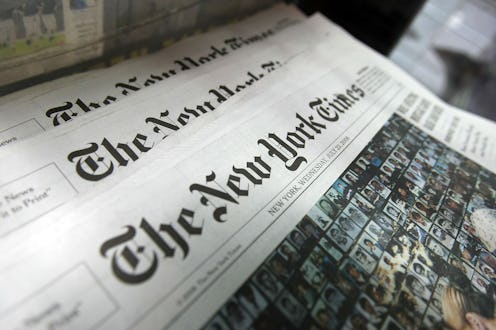News
Exactly How The NYT's Gender Discourse Evolved
Few things depict the movements, discourse, and language of a generation more accurately than its news coverage. That's why the New York Times, through its R&D Lab, created Chronicle, a New York Times graph tool that helps to visualize language usage in the famed newspaper throughout its history. What started out as a research tool used internally by NYT staff was made available to the public on Wednesday, so now anyone can play around with the tool and see how the newspaper has evolved.
In a statement, creator Alexis Lloyd explained:
Inspired by my own love of language and history, it’s a fascinating way to see historical events, political shifts, cultural trends or stylistic tropes. Chronicle can reveal things like the rise of feminism, evolution of cultural bêtes noires or when we shifted from talking about the 'greenhouse effect' to talking about 'climate change.'
Lloyd also mentions how Chronicle is an example of the "semantic listening" approaches the R&D Lab has been researching, which identify useful semantic signals in everything from conversations to web browsing histories to, in this case, "a historic corpus of news coverage."
The way it works is simple: You type in a word and the tool will graph how many times it's appeared in the paper over its 162 years of existence. We've graphed some specific terms to reflect how gendered discussion has evolved over time...
Is there any surer sign that we're heading toward gender equality than seeing two lines, one representing men and one representing women, meeting together on a graph?
Other than a brief period in the 1910s, most likely related to coverage of the women's suffrage movement, feminism was barely discussed until 1970.
Many topics related to women's rights didn't enter the public discourse until around 1970. And it's shocking to see that "sexual assault" basically didn't exist, according to the NYT's coverage, until the '60s.
Birth control has been a widely-covered subject in the last few decades, but that spike toward the end of the graph undoubtedly reflects how birth control has dominated social debate in the last few years.
For a frighteningly large swathe of the twentieth century, there was zero discussion of abortion.
The term "housewife" took a drastic dip in 1980, possibly signifying the word suddenly became taboo around then.
And just for fun, we graphed the evolution of these two terms that mean the same thing. The emergence of "flight attendant" in place of "stewardess" is just one fascinating example of how certain terms can become pejorative almost overnight.
Images: Chronicle/NYT Labs
